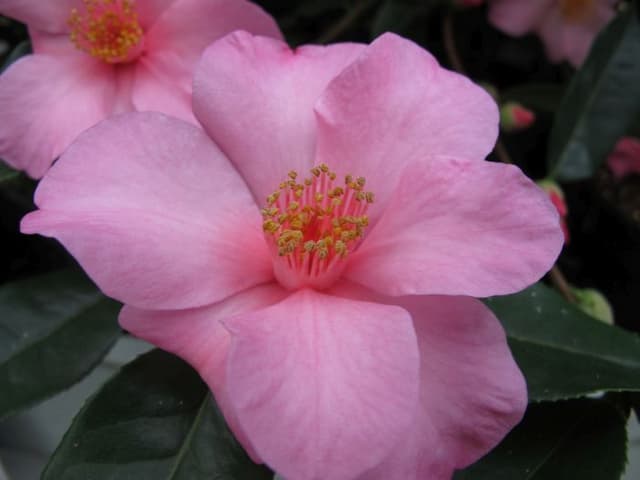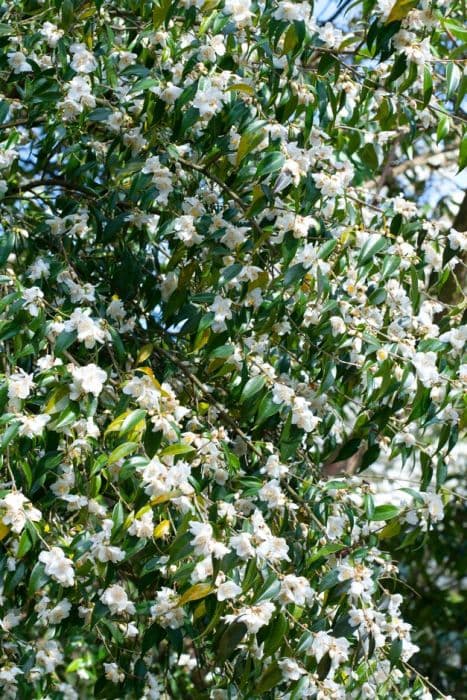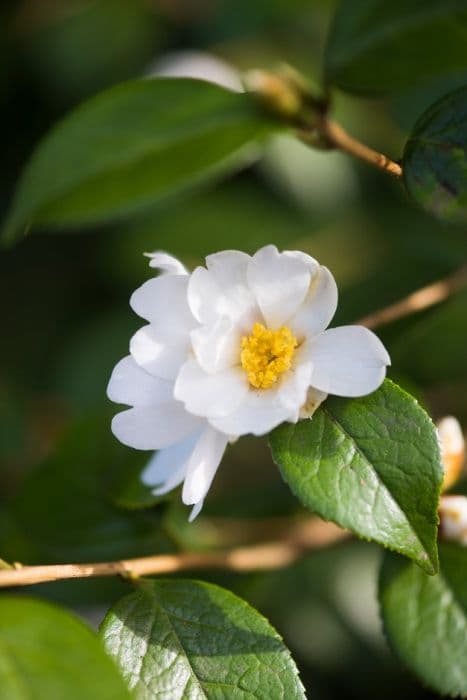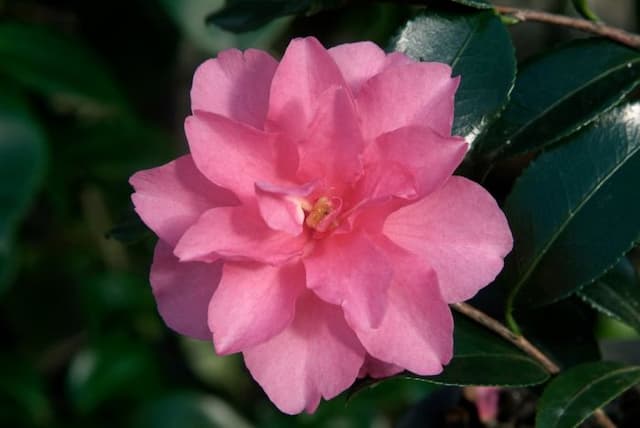Camellia Camellia 'Yoimachi' (fraterna × sasanqua)

ABOUT
The Camellia 'Yoimachi', a hybrid between fraterna and sasanqua varieties, is a visually striking shrub. It is known for its lush, glossy green leaves, which form a dense evergreen backdrop throughout the year. The foliage provides a perfect contrast to the delicate blossoms that emerge. The flowers of the 'Yoimachi' Camellia have a simple yet elegant aura, usually presenting as single or semi-double and boasting a pale pink to white hue. At times, the petals may show subtle veins or gradients of color, adding depth and interest to their appearance. The flower's center is adorned with a cluster of prominent golden-yellow stamens, which stand out against the softer colors of the petals and attract pollinators to the plant. These flowers tend to bloom in the cooler months, providing a splash of color when many other plants are dormant. The overall appearance of the Camellia 'Yoimachi' is one of resilience and beauty, with a bloom display that is both serene and captivating.
About this plant
 Names
NamesSynonyms
Yoimachi Camellia, Autumn Camellia, Winter Camellia.
Common names
Camellia 'Yoimachi'
 Toxicity
ToxicityTo humans
The Camellia (specifically Camellia 'Yoimachi') is not known to be toxic to humans. These plants are generally considered safe and there is no widespread evidence or documentation regarding poisoning upon ingestion. Consequently, no specific symptoms of poisoning or consequences due to ingestion of Camellia 'Yoimachi' are noted for humans.
To pets
Camellia 'Yoimachi', commonly referred to as just Camellia, is not commonly listed as a toxic plant to pets, including cats and dogs. There are no well-documented cases of poisoning from ingestion of Camellias in pets that would stipulate specific symptoms or consequences. Therefore, it is generally considered safe with respect to toxicity for pets.
 Characteristics
CharacteristicsLife cycle
Perennials
Foliage type
Evergreen
Color of leaves
Dark green
Flower color
White
Height
5 feet (1.5 meters)
Spread
4 feet (1.2 meters)
Plant type
Shrub
Hardiness zones
7
Native area
Japan
Benefits
 General Benefits
General Benefits- Ornamental Appeal: Adds aesthetic value to gardens with its delicate white flowers and evergreen foliage.
- Low Maintenance: Generally requires minimal care, making it suitable for novice gardeners.
- Drought Tolerance: Once established, it can withstand periods of dry weather, reducing the need for frequent watering.
- Cold Resistance: Able to survive in cooler temperatures, making it a versatile plant for various climates.
- Pest Resistance: Possesses a natural resilience to many common garden pests, lessening the need for chemical treatments.
- Privacy Screening: Dense growth habit makes it an excellent choice for hedges or privacy screens.
- Soil Adaptability: Tolerant of a range of soil types, including acidic and mildly alkaline conditions.
- Long Blooming Period: Offers a prolonged display of flowers through the late fall and winter months.
 Medical Properties
Medical PropertiesThis plant is not used for medical purposes.
 Air-purifying Qualities
Air-purifying QualitiesThis plant is not specifically known for air purifying qualities.
 Other Uses
Other Uses- Culinary Use: The leaves of the Camellia 'Yoimachi' can be used as a flavoring in culinary dishes, adding a unique aroma to certain recipes.
- Artistic Inspiration: Artists and photographers may take inspiration from the beautiful flowers of Camellia 'Yoimachi' for their artwork and compositions.
- Fabric Dye: The petals of Camellia 'Yoimachi' can be used to create a light, natural dye for fabrics, giving them a delicate color.
- Crafts: The dried flowers and leaves can be used in craft projects, such as making bookmarks, greeting cards, or potpourri.
- Education and Research: Camellia 'Yoimachi' can be used in educational settings to teach botany and plant hybridization techniques.
- Cultural Practices: In some cultures, the blooms may be used in traditional ceremonies or decorations due to their beauty and significance.
- Horticultural Training: The plant is ideal for master gardeners or horticulture students to practice pruning and care techniques for Camellia varieties.
- Natural Insect Repellent: The strong scent of the Camellia 'Yoimachi' flowers may help repel certain insects when planted in a garden setting.
- Companion Planting: Camellia 'Yoimachi' can be used in gardens to create aesthetically pleasing combinations with other plants that have similar care requirements.
- Theme Gardens: The plant can be a central feature in themes such as a 'moonlight garden' with its pale, moonlit colored flowers that stand out in the evening.
Interesting Facts
 Feng Shui
Feng ShuiThe Camellia is often associated with wealth and abundance in Feng Shui, so you might place it in the wealth corner of your garden or home, which is the southeast area, to enhance these aspects of your life. Its beautiful blooms also symbolize love and affection, making it suitable for the southwest sector, which governs love and marriage.
 Zodiac Sign Compitability
Zodiac Sign CompitabilityThe Camellia is not used in astrology practice.
 Plant Symbolism
Plant Symbolism- Adoration: Camellias often symbolize adoration or deep desire, as they are given to show someone that they are deeply admired.
- Perfection: The beauty and perfectly formed petals of the Camellia may represent the ideal or perfection, making them a symbol of an unimpeachable quality.
- Longevity: Because the Camellia is an evergreen with a long blooming season, it is frequently associated with longevity and enduring love or affection.
- Affection: The Camellia’s lush blooms and rich colors also represent affection and warmth towards others.
- Divine Love: In some cultures, specifically in Eastern traditions, the Camellia can symbolize divine or transcendent love, often connected to spiritual devotion.
 Water
WaterSasanqua camellias like 'Yoimachi' prefer evenly moist, well-draining soil and should be watered deeply once a week, depending on weather conditions. During hot or dry spells, it may require watering twice a week, while in cooler or rainy periods, less frequent watering is necessary. A good rule of thumb is to provide about 1 to 1.5 gallons of water for each watering session, ensuring that the root ball is thoroughly soaked. In the winter when the plant is dormant and the weather is cool, you can cut back on watering, reducing it to once every two to three weeks.
 Light
LightSasanqua camellias such as 'Yoimachi' thrive best in partial shade, where they can receive filtered sunlight or morning sun with afternoon shade. They can tolerate more sun in cooler climates, but should be protected from the hot midday sun, especially in warmer regions. An ideal spot is under the canopy of taller trees that allows dappled sunlight to reach the plant throughout the day.
 Temperature
TemperatureThe sasanqua camellia 'Yoimachi' performs best in temperatures ranging from 60 to 80 degrees Fahrenheit. It can tolerate minimum temperatures down to about 20 degrees Fahrenheit, but frost or prolonged exposure to temperatures below freezing can damage the plant. Ideal growing conditions for 'Yoimachi' include consistent temperatures within its preferred range, without extreme fluctuations.
 Pruning
PruningSasanqua camellias, including 'Yoimachi', should be pruned to maintain shape and remove any dead or diseased wood, as well as to encourage new growth and flowering. The best time to prune is after the blooming period ends, typically in late winter or early spring. Pruning can be done yearly, cutting back to just above a set of leaves, allowing the plant to regenerate and produce a lush foliage and bloom display for the next season.
 Cleaning
CleaningAs needed
 Soil
SoilThe best soil mix for Camellia 'Yoimachi', commonly known as a variety of camellia, should be well-draining and rich in organic matter, such as a blend of two parts peat moss to one part perlite and one part compost. Aim for a slightly acidic to neutral pH, between 5.5 and 7.
 Repotting
RepottingCamellias, including the 'Yoimachi', should be repotted every 2-3 years or when they outgrow their current pot, using the same slightly acidic to neutral soil mix.
 Humidity & Misting
Humidity & MistingCamellias thrive in moderate to high humidity levels, ideally around 40-60%, being careful to maintain good air circulation to prevent fungal issues.
 Suitable locations
Suitable locationsIndoor
Grow in bright, indirect light with high humidity.
Outdoor
Plant in partial shade, sheltered from strong winds.
Hardiness zone
7-9 USDA
 Life cycle
Life cycleThe Camellia 'Yoimachi' (commonly referred to by the species name Camellia), begins its life cycle as a seed, which, when planted in well-draining, acidic soil and given proper moisture and temperature conditions, will germinate. Following germination, the seedling emerges, gradually developing true leaves and establishing a root system. As the Camellia grows, it enters a vegetative stage where it focuses energy on leaf and stem growth, with regular watering and partial shade aiding its development. Once mature enough, often within a few years, it starts to produce flower buds in late summer or autumn; these buds will bloom into the characteristic flowers of the Camellia from fall to winter, depending on the climate. After pollination, which may involve insects or wind, the flowers develop into fruiting capsules that contain the seeds for the next generation. Finally, when the plant has reached its natural end of life, which can span several decades with proper care, it will die back, completing its life cycle.
 Propogation
PropogationPropogation time
Early Spring
The most popular method of propagation for the Camellia 'Yoimachi', also known as Yoi Machi Camellia, is through semi-hardwood cuttings. This process typically takes place during the late summer or early fall. To accomplish this, a cutting of about 4 to 6 inches (10 to 15 centimeters) is taken from a healthy part of the plant, ensuring it has several leaves. The cut end of the stem is dipped into a rooting hormone to encourage growth and then planted in a small pot filled with a mixture of peat and perlite to provide good drainage and aeration. The cutting is then kept under high humidity and indirect light until roots have developed, which can take several weeks. Once the cutting has established a strong root system, it can be transplanted into a larger pot or directly into the garden.









